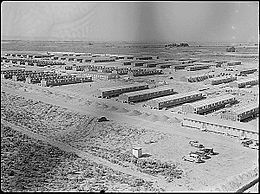Camp Minidoka
| Minidoka National Historic Site | |
|---|---|
|
IUCN category V (protected landscape/seascape)
|
|

Minidoka War Relocation Center in 1943
|
|
| Location | Jerome County, Idaho, U.S. |
| Nearest city | Eden |
| Coordinates | 42°40′44″N 114°14′38″W / 42.679°N 114.244°WCoordinates: 42°40′44″N 114°14′38″W / 42.679°N 114.244°W |
| Area | 210 acres (85 ha) |
| Authorized | January 17, 2001 |
| Governing body | National Park Service |
| Website | Minidoka National Historic Site |
Minidoka National Historic Site is a National Historic Site in the western United States. It commemorates the more than 9,000 Japanese Americans who were imprisoned at the Minidoka War Relocation Center during the Second World War.
Located in the Magic Valley of south central Idaho in Jerome County, the site is in the Snake River Plain, a remote high desert area north of the Snake River. It is 17 miles (27 km) northeast of Twin Falls and just north of Eden, in an area known as Hunt. The site is administered by the National Park Service of the U.S. Department of the Interior, and was originally established as the Minidoka Internment National Monument in 2001. Its elevation is just under 4,000 feet (1,220 m) above sea level.
The Minidoka War Relocation Center was in operation from 1942–45 and one of ten camps at which Japanese Americans, both citizens and resident "aliens," were interned during World War II. Under provisions of President Franklin D. Roosevelt's Executive Order 9066, all persons of Japanese ancestry were excluded from the West Coast of the United States. At its peak, Minidoka housed 9,397 Japanese Americans, predominantly from Oregon, Washington, and Alaska.
...
Wikipedia

